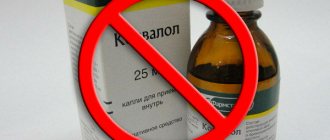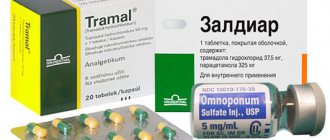Tramadol is a very old opioid painkiller. The pharmaceutical drug is used to eliminate severe pain; to a greater extent, the drug is prescribed to cancer patients. The analgesic effect of Tramadol is 5 times less than that of morphine. The medication is sold as a single drug or in combination with paracetamol.
Group: pharmaceutical drugs
Is Tramadol a drug?
At the initial stage of studying tramadol, it was recognized that pain relief occurs due to the participation of the opioid system, the medication was classified as a narcotic painkiller.
Trambadol
The small number of side effects is explained by the establishment of a mixed mechanism of action. In Russia, the analgesic is included in the group of vital and essential drugs.
Consequently, according to the current classification, Tramadol is not considered a narcotic substance, but is classified as a potent drug. The medication is not dispensed without a prescription from the attending physician.
Use in doses exceeding the therapeutic range contributes to the formation of dependence.
Instructions for use
As mentioned above, Tramadol is sold in pharmacies only with a doctor's prescription. The prescription is written out on form 148-1/у-88.
Rp.: Tab. Tramadoli 0.1 DtsN 30 S. 1 tablet. * 2 w.d.
In tablets
The tablets are taken orally, without chewing, swallowing whole. It is important to take the medicine with enough water.
The medicine is used exclusively as prescribed by the doctor, the dosage is selected individually for each patient, it all depends on the severity of the pain. Recommended dosages are only indicative; the duration of treatment with tablets is determined by the doctor personally for each patient. When treating chronic pain, an analgesic dosage schedule should be followed.
You should not take more than 8 tablets with a dosage of 50 mg or 4 tablets with a dosage of 100 mg per day (exceptions: postoperative pain, oncology).
A single dose for persons over 14 years of age (weight over 25 kg) is equal to 1 tablet with a dosage of 50 mg or half a tablet with a dosage of 100 mg. If the pain does not go away, you can take 1 more tablet after an hour.
For severe pain, a single dose may be 100 mg.
In persons over 75 years of age, in patients with renal or liver failure, Tramadol is eliminated from the body more slowly. It may be advisable to increase the time between new doses.
In ampoules
Solution for injection 50 mg/ml and 100 mg/2 ml.
The doctor selects the dosage of the drug individually for each patient.
For persons over 14 years of age, the drug is administered slowly by drip, 1 ml-2 ml of solution (50-100 mg), 400 mg is the permissible dosage per day. When administered subcutaneously or intramuscularly, the drug is taken in the same dosage. A repeat drip can be placed only after 4 hours.
The recommended dosage per day should not exceed 400 mg, but in severe cases, doctors take the liberty of increasing the dosage to 600 mg.
For patients with kidney or liver failure, doctors may prescribe a lower dosage of pain medication.
Video on the topic:
Tramadol
Tramadol is used as prescribed by a doctor; the dosage regimen of the drug is selected individually depending on the severity of the pain syndrome and the sensitivity of the patient. The duration of treatment is determined individually; the drug should not be prescribed beyond the period justified from a therapeutic point of view.
Tramadol is intended for intravenous (administer slowly), intramuscular, or subcutaneous administration. Unless otherwise prescribed, Tramadol should be prescribed in the following dosages.
For adults and teenagers over 14 years old
for a single administration of 50-100 mg of tramadol hydrochloride (1-2 ml of solution for injection). If satisfactory analgesia does not occur, a repeat single dose of 50 mg (1 ml) may be prescribed after 30-60 minutes. For severe pain, a higher dose (100 mg tramadol hydrochloride) may be prescribed as an initial dose. In general, 400 mg of tramadol hydrochloride/day is usually sufficient to relieve pain.
For the treatment of pain due to cancer and severe pain in the postoperative period
Higher doses may be used.
Children over 1 year of age
injection solution can be prescribed in a single dose at the rate of 1-2 mg/kg of the child’s body weight. A daily dose of 4-8 mg/kg body weight is usually sufficient. Tramadol is diluted with water for injection. Dilute Tramadol with water to obtain final concentration.
| 1 ml of the drug contains 50 mg of tramadol | |
| Tramadol+water | Concentration |
| 1 ml + 1 ml | 25.0 mg/ml |
| 1 ml + 2 ml | 16.7 mg/ml |
| 1 ml + 3 ml | 12.5 mg/ml |
| 1 ml + 4 ml | 10.0 mg/ml |
| 1 ml + 5 ml | 8.3 mg/ml |
| 1 ml + 6 ml | 7.1 mg/ml |
| 1 ml + 7 ml | 6.3 mg/ml |
| 1 ml + 8 ml | 5.8 mg/ml |
| 1 ml + 9 ml | 5.0 mg/ml |
| 2 ml of the drug contains 100 mg of tramadol | |
| Tramadol+water | Concentration |
| 2 ml + 2 ml | 25.0 mg/ml |
| 2 ml + 4 ml | 16.7 mg/ml |
| 2 ml + 6 ml | 12.5 mg/ml |
| 2 ml + 8 ml | 10.0 mg/ml |
| 2 ml + 10 ml | 7.1 mg/ml |
| 2 ml + 14 ml | 6.3 mg/ml |
| 2 ml + 16 ml | 5.8 mg/ml |
| 2 ml + 18 ml | 5.0 mg/ml |
Example:
To administer a dose of 1.5 mg of tramadol hydrochloride per kg of body weight to a child weighing 45 kg, 67.5 mg of tramadol hydrochloride is required. To do this, 2 ml of Tramadol is diluted with 4 ml of water for injection to a final concentration of 16.7 mg of tramadol hydrochloride per milliliter. Then 4 ml of the diluted solution is administered (total dose is approximately 67 mg of tramadol hydrochloride).
It is possible to dilute injection solutions with solutions for infusion for intravenous administration. In this case, 0.9% sodium chloride solution or 5% glucose solution is used for dilution.
In elderly patients
(aged 75 years or more) due to the possibility of delayed elimination, the interval between administrations of the drug can be increased in accordance with individual characteristics.
In patients with kidney and liver diseases
Tramadol may last longer. For such patients, the doctor may recommend increasing the interval between single doses.
Tramadol should not be prescribed for longer than therapeutically necessary.
Drug effect and side effects
Drug addicts taking Tramadol experience:
- A feeling of bliss that lasts almost the entire period of intoxication
- Duration of the trip is about 10 hours
- Excitement due to the duality of the mechanism of action
- Slowness, lethargy, drowsiness
- Getting a "high" from ordinary things that caught their attention (watching a tree)
Symptomatic therapy with the drug often goes well. But exceeding the dose and using it for non-medical purposes is accompanied by the following symptoms:
- Increased heart rate
- Headache
- Excessive sweating
- Muscle weakness
- Nausea and vomiting
- Insomnia
- Impaired coordination of movements
- Severe lethargy
- Stomach ache
- Allergy
- Dyspnea
- Swallowing disorder
- Urinary retention
Tramadol Kalcex
The most common side effects are nausea, vomiting, constipation, dry mouth, biliary spasms, dizziness, noted in more than 10% of patients.
In the following, the indicated side effects are arranged according to the classification of organ systems, as well as the frequency of occurrence: very often (≥1/10), often (≥1/100 to <1/10), infrequently (≥1/1000 to <1/100) , rare (≥1/10,000 to <1/1000), very rare (<1/10,000), unknown (cannot be determined from available data).
From the immune system
Rare: allergic reactions (eg, shortness of breath, bronchospasm, wheezing, angioedema) and anaphylaxis.
Metabolism and nutrition
Rarely: changes in appetite.
Frequency unknown: hypoglycemia.
From the mental side
Rare: hallucinations, confusion, sleep disturbances, delirium, anxiety and nightmares. After using tramadol, rarely observed side effects from the psyche are possible (depending on the personality characteristics of the patient and the duration of treatment). These side effects include changes in mood (usually euphoria, sometimes dysphoria), changes in activity (usually decreased activity, sometimes increased), and disturbances in cognitive and sensory abilities (eg, decision-making, perceptual disturbances). Drug dependence may develop. Possible symptoms of opioid withdrawal include agitation, anxiety, nervousness, sleep disturbances, hyperkinesia, tremor, and gastrointestinal symptoms.
Other symptoms that are very rare when stopping tramadol include: panic attacks, severe anxiety, hallucinations, paresthesia, tinnitus and extremely rare central nervous system symptoms (confusion, hallucinations, depersonalization, derealization, paranoia).
From the nervous system
Very common: dizziness.
Common: headache, drowsiness.
Rarely: paresthesia, tremor, epileptic convulsions, involuntary muscle contractions, coordination problems, fainting, speech disorders.
Seizures usually occur after the use of large doses of tramadol or when used simultaneously with drugs that lower the seizure threshold.
From the side of the organ of vision
Rarely: miosis, mydriasis, blurred vision.
From the side of the heart
Uncommon: effects on cardiovascular regulation (palpitations, tachycardia). These side effects are mainly observed with intravenous administration of the drug or with significant physical exertion.
Rarely: bradycardia.
From the side of blood vessels
Uncommon: effects on cardiovascular regulation (orthostatic hypotension or cardiovascular collapse). These side effects are mainly observed with intravenous administration of the drug or with significant physical exertion.
Rarely: arterial hypertension.
From the respiratory system, chest and mediastinum
Rarely: respiratory depression, shortness of breath.
If recommended doses are significantly exceeded and other drugs that depress the central nervous system are used simultaneously, respiratory depression is possible.
A deterioration in bronchial asthma was noted, but a cause-and-effect relationship with the use of the drug was not established.
From the gastrointestinal tract
Very common: nausea.
Common: constipation, dry mouth, vomiting.
Uncommon: gagging, feeling of heaviness in the stomach, flatulence, diarrhea.
From the liver and/or biliary tract
Very rare: in some cases, an increase in the activity of liver enzymes was noted, but the time coincided with tramadol therapy.
From the skin and subcutaneous tissues
Common: hyperhidrosis.
Uncommon: skin reactions (eg, itching, erythema, urticaria).
From the musculoskeletal and connective tissue side
Rarely: muscle weakness.
From the kidneys and urinary tract
Rarely: urinary disorders (dysuria and urinary retention).
General disorders and reactions at the injection site
Often: fatigue.
How to relieve withdrawal symptoms from Tramadol
Dependence on Tramadol is very strong. Rapid withdrawal of the drug provokes the development of withdrawal symptoms.
Psychological symptoms of withdrawal:
- Hallucinations
- Aggressiveness
- Depression
- Hysterics
- Suicidal tendencies
The physical manifestations of withdrawal are the same as the side effects that occur when taking medications in high doses.
If withdrawal symptoms occur, it is better to seek help from a doctor. Detoxification will help relieve the painful symptoms of withdrawal.
The doctor will develop a schedule for stopping the medication and prescribe a diet. During treatment it is necessary to stop drinking alcohol.
How long does it stay in urine?
Metabolites of the drug remain in the urine for about a week. The half-life depends on the regularity of use of the analgesic and the presence of problems with the urinary system.
Tramadol for oncology
The medicine will be prescribed to cancer patients if pain does not decrease after using less toxic but highly effective painkillers. Long-term use of opiates risks addiction.
But in cancer patients in the terminal stage and with metastases, drug addiction is excluded.
Overdose
Persons over 14 years of age are usually prescribed 50 mg of the drug at a time (1 tablet). Repeated administration of the tablet form is allowed after 30-60 minutes if the desired effect does not occur.
The permissible single dose for injection is 50-100 mg (1-2 ampoules). Repeated administration should be carried out no earlier than after 4 hours.
The maximum dose of the drug per day for persons over 14 years of age is 400 mg, sometimes the dosage is increased to 600 mg. Elderly people should not take more than 300 mg of the drug per day.
Usually, for children under 14 years of age, the doctor prescribes Tramadol in the form of injections or drops. A single dosage depends on the patient’s weight (1-2 mg/kg), the maximum dosage per day should not exceed 8 mg/kg.
Increasing these dosages can lead to coma and death. If symptoms of overdose occur, it is important to provide fresh air to the patient and urgently call an ambulance.
Tramadol, 50 mg/ml, solution for injection, 2 ml, 5 pcs.
Tablets:
orally,
with a small amount of liquid. The drug is used as prescribed by a doctor, the dosage regimen is selected individually, depending on the severity of the pain syndrome and the sensitivity of the patient. The duration of treatment is determined individually; the drug should not be prescribed beyond the period justified from a therapeutic point of view.
In the absence of other prescriptions, the drug should be prescribed in the following dosages: orally for a single use in adults and children over 14 years of age - 50 mg, after 30-60 minutes the same dose can be repeated, but not more than 8 doses per day. The maximum daily dose is 400 mg.
Elderly people (75 years and older) and patients with renal failure require individual dosage. When creatinine Cl is less than 30 ml/min and in patients with liver failure, a 12-hour interval is required between taking subsequent doses of the drug.
Solution for injection:
intravenously
(injected slowly, no more than 1 ml of solution per minute, which corresponds to 50 mg of tramadol),
intramuscularly, subcutaneously
. To dilute the drug, you can use water for injection, saline solution and 5% dextrose solution.
Dilution of the drug Tramadol with water to obtain the final concentration is shown in the table.
Table
| Drug volume, ml | Volume of water for injection, ml | Resulting concentration, mg/ml |
| 1 or 2 | 1 or 2 | 25 |
| 1 or 2 | 2 or 4 | 16,7 |
| 1 or 2 | 3 or 6 | 12,5 |
| 1 or 2 | 4 or 8 | 10 |
| 1 or 2 | 5 or 10 | 8,3 |
| 1 or 2 | 6 or 12 | 7,1 |
| 1 or 2 | 7 or 14 | 6,3 |
| 1 or 2 | 8 or 16 | 5,6 |
| 1 or 2 | 9 or 18 | 5 |
The doses recommended below are indicative. In practice, it is necessary to select the minimum analgesically effective dose. The duration of treatment with the drug is determined individually. Do not use longer than is justified from a therapeutic point of view.
Adults and teenagers over 14 years of age:
single dose - 50-100 mg, repeated administration of the drug after 4-6 hours is possible. Maximum daily dose - 400 mg.
Children from 1 to 14 years old:
single dose 1-2 mg/kg, maximum daily dose - 8 mg/kg.
Patients with impaired renal and/or liver function.
In patients in these categories, it is difficult to remove tramadol from the body. In the case of the treatment of acute pain syndromes in such patients, when a rare or single dose of tramadol is necessary, no special dosage changes are required. However, in the case of treatment of chronic pain, it is necessary to remember the danger of accumulation of the drug in the body, therefore it is advisable to increase the intervals between its individual doses. The drug should be prescribed with caution to patients with impaired renal function (50–100 mg 2 times a day), as well as to persons with cirrhosis of the liver (in this group of patients, T1/2 of tramadol increases almost 3 times).
Elderly patients.
In elderly patients (over 75 years of age), the elimination of tramadol from the body slows down, even when there are no clinical manifestations of impaired renal and/or liver function. In these patients, it is also necessary to increase the intervals between individual doses of the drug. It is recommended not to exceed the daily dose of 300 mg.
Addiction
Therapeutic doses of the drug usually do not cause pathological desire. However, a slight increase in dose leads to physical and psychological dependence.
As a result of regular use of the drug for 3 months, it becomes the only and “unique” drug for a person.
Physical cravings for the drug can be overcome, but fighting mental cravings requires patience and special efforts.
Even after detox therapy, Tramadol is not completely eliminated from the body.
Compatibility with other drugs
Taking Tramadol and pregabalin together may cause constipation. To avoid this, it is necessary to follow preventive measures against intestinal obstruction and constipation.
Simultaneous use of an opioid painkiller with Analgin and Ketorol leads to increased toxic effects (drugs cannot be mixed).
Ketonol should not be mixed with Tramadol to avoid side effects.
When dealing with moderate pain due to cancer, the combination Tramadol + Diphenhydramine (increases the analgesic effect) is excellent.
If a doctor prescribes Tramadol, the patient must completely stop drinking alcohol.
The simultaneous use of Tramadol and Morphine can lead to breathing problems and arterial hypotension.
Combining Phenazepam and Tramadol can lead to increased side effects.
Tramadol for toothache
Tramadol is a mixed action analgesic. For severe toothache, an opioid pain reliever will help.
However, when taking Tramadol, you should be sure to familiarize yourself with the possible side effects and follow the dosage.
When the opportunity arises, you should immediately contact your dentist.
Tramadol for cats and dogs
Veterinarians prescribe opioid pain medication to dogs and cats for severe pain or after surgery, cancer, or injury. In addition, Tramadol is used to relieve pain in older dogs.
Depending on the situation, the recommended dose of medication for dogs can vary from 1.1 mg/kg to 9.9 mg/kg. The medication can be taken orally every 8 hours.
The recommended single dosage for cats is 3 mg/kg, repeated dosage is allowed only after 8 hours.
Tramadol
In patients with opioid dependence, head injuries, shock, in patients with disturbances of consciousness of unknown etiology, breathing disorders or damage to the respiratory center, increased intracranial pressure, tramadol should be used only with extreme caution.
The simultaneous use of tramadol with benzodiazepines or other substances that suppress the activity of the central nervous system (including non-benzodiazepine hypnotics, anxiolytics, tranquilizers, muscle relaxants, general anesthetics, neuroleptics, other opioids, alcohol) can increase sedation, respiratory depression, even coma and of death. Therefore, caution should be exercised when concomitantly prescribing sedatives in patients for whom alternative treatment options are not available. When deciding whether to prescribe tramadol concomitantly with sedatives, the lowest effective dose should be used and the duration of therapy should be as short as possible. For patients already receiving an opioid analgesic, give a lower initial dose of the benzodiazepine or other CNS depressant than indicated in the absence of the opioid and titrate based on clinical response. If an opioid analgesic is prescribed to a patient already taking a benzodiazepine or other CNS depressant, use a lower initial dose of the opioid analgesic and titrate based on clinical response. Close monitoring for signs and symptoms of respiratory depression and sedation is advisable.
Metabolism via CYP2D6 isoenzyme
Tramadol is metabolized by the CYP2D6 isoenzyme. In patients with insufficient activity (patients with “slow” metabolism) or absence of this isoenzyme, an adequate analgesic effect may not be achieved. It is estimated that up to 7% of Caucasians may have insufficient activity of this isoenzyme. At the same time, patients with “ultra-fast” metabolism are at risk of developing side effects of opioid toxicity, even when taking tramadol in recommended doses.
Common symptoms of opioid toxicity include confusion, drowsiness, shallow breathing, severe pupillary constriction, nausea, vomiting, constipation and lack of appetite. In severe cases, life-threatening cardiovascular disorders and respiratory depression may occur, and in rare cases, death. Estimation of the prevalence of patients with “ultra-rapid” metabolism in various populations:
| Population | Prevalence, % |
| East African | 29 |
| African American | 3,4-6,5 |
| Mongoloid | 1,2-2 |
| Caucasian (“Caucasian” type) | 3,6-6,5 |
| Mediterranean (Greek) | 6,0 |
| Central European (Hungarian) | 1,9 |
| Northern European | 1-2 |
Postoperative use in children
There are reports in the published literature that the use of tramadol in children after tonsillectomy and/or adenoidectomy for obstructive sleep apnea has resulted in rare but life-threatening adverse reactions. When tramadol is prescribed to children for postoperative pain relief, extreme caution should be used and close monitoring for symptoms of opioid toxicity, including respiratory depression.
Children with breathing problems
Tramadol is not recommended for use in children with respiratory problems, including neuromuscular diseases, serious heart or respiratory disease, upper respiratory or lung infections, multiple traumas, or major surgery. These factors can lead to worsening symptoms of opioid toxicity.
Sleep-related breathing disorders
Opioids can cause sleep-related breathing disorders, including central sleep apnea (CAS) and sleep-related hypoxemia. Opioid use increases the risk of CSA in a dose-dependent manner. For patients with CSA, consider reducing the total dose of the narcotic analgesic (opioid).
The drug should be used with caution in patients with known cases of severe opioid intolerance of allergic and non-allergic origin.
Cases of seizures have been reported in patients taking tramadol at recommended doses. The risk of developing seizures may increase if the maximum recommended daily dose of the drug (400 mg) is exceeded. Taking tramadol may increase the risk of seizures in patients taking drugs that lower the seizure threshold. Patients with epilepsy and patients susceptible to seizures should take tramadol only for health reasons.
The use of Tramadol may lead to the risk of developing adrenal insufficiency and the risk of decreased sex hormone levels with long-term use of the drug.
It is possible to develop addiction, physical and mental dependence, especially with prolonged use. In patients prone to drug abuse or the development of drug dependence, treatment with Tramadol should be carried out only in short courses and under medical supervision.
Tramadol is not suitable as a replacement therapy for patients with opioid dependence. Although tramadol is an opioid agonist, it cannot suppress morphine withdrawal symptoms.
If the patient no longer requires tramadol therapy, it is advisable to reduce the dose gradually to prevent withdrawal symptoms.









